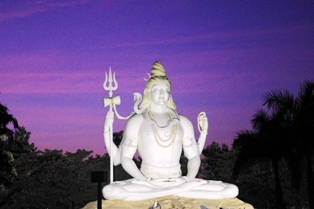Who looks outside dreams; who links inside awakes
Is there at all or is there still a secret of the Veda? The heart of that ancient mystery has been plucked out and revealed to the gaze of all or rather no real secret existed. To get to the bottom of this secret, I packed my bags and took the journey to the remote Po Lin monastery in Hong Kong. The road to the top of the mountain though is rough and bumpy but the view and scenery around is spectacular. Witness the rare transition of lush forest ecosystem in just a few miles on the highest elevation road and that’s when you are bound to see the Tian Tan Buddha or the Big Buddha, thirty four meters majestic bronze Buddha draws every eye on him.
Cross legged,
sitting in the half lotus position, the eyes, lips, the incline of the head and
his right hand raised to give blessings to all, portrays a humbling depth of
character and solemnity to the huge statue; which took twelve years to
complete.
One has to climb the 268 steps to reach near
the Buddha in Abhaya Mudra. Facing the Buddha are his three disciples offering
him hyms of prayer.
The first
holding the “Diya” or lamp, whose quality of significance is a pre-eminent
force or intensity whether in state, action, sensation or movement; but the
qualities of this essential significance vary. The “Flame” means a burning
brightness whence use for fire; For movement specially the “diyas” serpentine
movement means strength and force,
beauty and splendor, leading and pre-eminence, sometimes it means angry
passion, when “God” is not answering to your prayers other times, delight and
love.
The middle one
holding a tray of sweet dumplings. Right from the Hindu Veda which transformed
to Buddhism, our Yogis were very practical, they knew from experience that to
get something even from God” one has to give something and that is in form of
sweets.
The third one is
offering a Lotus; symbolizes mental purity and spiritual perfection. Its eight
petals relates to the Noble 8 folds path of Good law. It is the lotus found at the heart of the
Garbhadhatu Mandala, being
the womb or embryo of the world. It is characteristic of the esoteric sects,
and the lotus of the Buddhas.
Out of curiosity, I
asked the monk that why three women statues, does it have any special
significance?
The answer took me to
do further research on the time and how Buddhism spread. Buddhist expansion
started somewhere around the 6th century BC from the heartland of
northern India to Central, East and Southeast Asia.
The history of Buddhism
is characterised by numerous schisms, movements and also development of trade.
But the most important of these was a similar status given to Women in society,
to an extent abolishment of high and low which had risen due to extreme
orthodox ways of practising Hinduism at the time.
After asceticism and
meditation, Gautam Buddha discovered the middle way- a path of moderation away
from the extremes of self indulgence and self mortification. Wisdom and
enlightenment is the root of any path of worship, enforced practice of rituals
pertaining to any religion is not the correct way to salvation. Thus when one
is in peace with oneself that’s the way one comes close to God.




Comments
Post a Comment